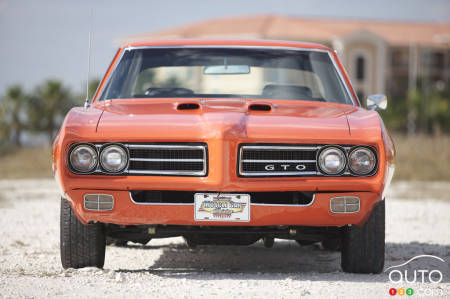If you’re a true-blue lover of cars, no matter where they’re made or their main vocation, you know what a muscle car is. For everyone else, here’s a brief description…
The concept of the muscle car is as all-American as, well, apple pie. In the immediate aftermath of World War II, while Europe struggled to right itself after a difficult period and Asia sought to adapt to modern realities, the American automotive industry caught its breath and set to work to meet the growing demand for performance-minded cars among young consumers. The beginning of the 1950s saw new V8 engines, much more powerful and efficient than before, appear in American automobiles.
The generation of true muscle cars, however, would take another decade or so to develop. In the early 1960s, U.S. drag strips began featuring races with large American coupes equipped with equally large V8 engines (7.0L or more) and multiple carburetors. It was the era of the Super Stock (SS) cars.
It was around this time that John Z. DeLorean, then GM’s resident guru (and yes, the same man who would create the legendary sports car that bore his name), had the brilliant idea of fitting one of the new oversized multi-carburetor V8s – all 389 cubic inches or 6.3 litres of it – under the hood of a mid-size Pontiac Le Mans. Thus was born the very first real muscle car in history: the Pontiac GTO.
It wasn’t long before GM’s competitors followed suit. In a matter of months, the market was inundated with the Chevrolet Chevelle SS, the Ford Fairlane 390 and then 427, the Plymouth Road Runner 383 or HEMI and quite a few more. Even independent automotive companies got in on the act, with American Motors equipping its Rebel with a 6.5L (401 cubic-inch) V8 and Studebaker placing a supercharged V8 289 (4.9L) in its Lark model. The big American designers pushed things even further by jamming ‘big block’ V8s into the engine compartments of vehicle considered compact at the time. GM was an industry leader in this parade of madness, most memorably with its Chevrolet Nova 396.
In a nutshell, then, muscle cars were basically the period’s smaller cars fitted with immense, powerful engines, while their engineers treated things like road handling, steering and braking as little more than after-thoughts. They were also utterly lacking in anything approaching luxury or quality finishing. In truth they were lower-range coupes with basic interiors, often even lacking radios, but fitted with impressively powerful powertrains able to produce remarkable drag-strip times.
Muscle car or pony car?
While purists prefer to limit their definition of muscle cars to mid-size or compact coupes, others bring sports coupes like the Ford Mustang, Chevrolet Camaro, Mercury Cougar, Pontiac Firebird, Dodge Challenger, Plymouth Barracuda and AMC Javelin into the discussion. These cars were actually labeled as pony cars, in reference to the standard-setting Mustang. Depending on the engine set-up lurking under the hood, they could be considered sports cars (many were quickly adopted for use in road-circuit racing, even giving rise to the legendary American Trans Am series) or actual muscle cars (when fitted with one of those immense super-powerful V8s able to tear up the drag-strip asphalt).
The golden age of muscle cars lasted into the early 1970s, when the oil crisis hit North America hard. Another nail in their coffin was the establishment of new standards by the National Highway Traffic Safety Administration (NHTSA), which had the effect not only of altering certain aspects of automobiles being produced, but of putting a stop to the performance arms-race being waged by the manufacturers. The last muscle cars rolled off production lines in the mid-70s, but by then those models did not have anywhere near the muscle their big-block predecessors had enjoyed a decade earlier.
What remains of this love affair?
Muscle cars thus disappeared almost as quickly as they had appeared. These days it would be pretty difficult, if not impossible, to recreate this legendary period in automotive history. And yet, just recently, several automakers tried to do just that. Even European and Japanese manufacturers took the initiative to install V8s and other powerful engines into even their smallest cars. Contrary to the original muscle cars that inspired them, however, these new editions proved to be extremely expensive.
The only remaining vestiges of the short-lived muscle-car era reside in the few pony cars still active in the market, such as the Ford Mustang, Chevrolet Camaro et Dodge Challenger. These models are available with impressive V8 engines (even while Ford offers a 2.3L 4-cylinder turbo engine delivering over 300 hp in its Mustang, which makes it more powerful that the 6.2L 390 that came in its 60s-era ancestor, and while GM and Dodge offer a V6 delivering over 300 hp in their current Camaro and Challenger models). Ever-mindful of their 1960s legacies, Detroit’s Big Three also create genuine muscle-car versions of their coupes for fans of drag racing, namely the Mustang Cobra Jet, the Chevrolet Camaro COPO and the Challenger Drag Pack. Of course, these cars are not designed to be driven on the road!
Other than these few pony cars, muscle cars such as they once existed are now a virtually extinct species, with the possible exception of the Dodge Charger SRT Hellcat or the Scat Pack with V8 HEMI (Ed.: this article was written prior to the launch of the very muscular Challenger SRT Demon). And in terms of the cost associated with acquiring one of these new special edition cars, the new generation is worlds removed from those reasonably priced muscle cars of the ever-more-distant past!



